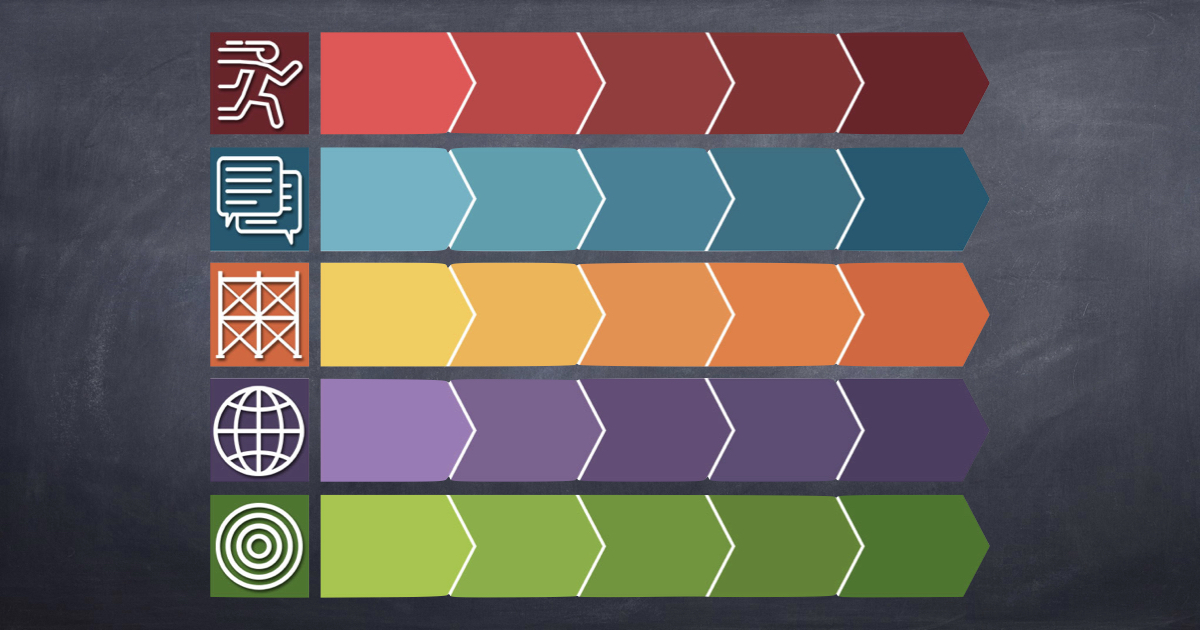
The Second Handbook of Information Technology in Primary and Secondary Education is out this year and it includes an article by Scott McLeod entitled, “Technology Integration, Leadership, and Organizational Support Frameworks for Instructional Improvement with Information Technology.”
McLeod’s chapter provides a fairly thorough list of published models of technology integration, including the Technology Integration Matrix (TIM). Regarding basic continuum models like SAMR, McLeod suggests, “Schools that find the relative vagueness of the continuums to be insufficient to guide their work could utilize one of the more specific frameworks, for example, either the Florida or Arizona Technology Integration Matrix – or the LoTi framework – to add depth and context to their conversations” (pp. 539-40). (Just for the record, all versions of the TIM originated in Florida, although we are happy to share with our friends out west. 🙂) McLeod’s discussion of the full array of different integration models got us thinking about the nature of models, what they reveal, and how to use them effectively.
All models, physical or mental, are abstractions. As such, models necessarily simplify and distort some details in order to reveal others. For example, think of a traditional model of our solar system common to many elementary science classrooms. Most such models are focused on the number and sequence of planets and other objects orbiting the sun and do not (and are not intended to) represent actual scale and distance of these objects. If they were made to scale, they would be impractical and difficult to understand. When evaluating a model, it’s always important to understand the purpose of the model, what it reveals, and what it omits or distorts.
Which technology integration model is best? To quote a wise person, it depends. When considering models of technology integration, it is vital to consider the specific needs and goals of your school or district and the purposes and strengths of the models available.
For example, the TPACK model (Technological, Pedagogical, and Content Knowledge) illustrates the domains of knowledge a teacher needs in order to effectively integrate technology. In coaching, TPACK can be used to help build the confidence of a teacher who may be a apprehensive about technology by emphasizing his or her strengths in pedagogical and content knowledge. This is just one example of many practical ways to apply this versatile theoretical model to improving instruction. One limitation of TPACK is that it does not describe how teachers may develop strengths in each of its components (although a great deal of professional development material has been created based on the TPACK). This is not a flaw in the model; developmental levels are outside of the purpose of the TPACK model.
The levels within the Technology Integration Matrix (Harmes, Welsh, & Winkelman, 2016) represent a continuum of pedagogical choices available to a teacher in designing a technology infused lesson. The characteristics provide a series of lenses to contextualize those pedagogical choices. Both the TIM levels and the TIM characteristics refocus attention on elements of effective pedagogy rather than on elements of technology. The levels provide an entry point for a teacher who is just getting started with a new technology as well as proximal steps toward more challenging and more student-centered uses of technology. The TIM describes a range of effective practices and fundamentally rejects the notion of a one-size-fits-all approach. A limitation of the TIM is that it does not describe the areas of knowledge necessary for a teacher to implement a lesson — which is one of the reasons the TIM pairs well with the TPACK.
Regardless of which of the many models of technology integration best fit your current needs, be sure to adopt a model that matches your mission and goals and re-examine your choices on a regular basis as the needs of your organization change.
For more information on the Technology Integration Matrix, please visit fcit.usf.edu/matrix/.
Harmes, J. C., Welsh, J. L., & Winkelman, R. J. (2016). A framework for defining and evaluating technology integration in the instruction of real-world skills. In S. Ferrara, Y. Rosen, & M. Tager (Eds.), Handbook of research on technology tools for real-world skill development (pp. 137-162). Hershey, PA: IGI Global.
McLeod, S. (2018). “Technology Integration, Leadership, and Organizational Support Frameworks for Instructional Improvement with Information Technology” in J. Voogt et al. (eds.), Second Handbook of Information Technology in Primary and Secondary Education, Springer International Handbooks of Education, https://doi.org/10.1007/978-3-319-71054-9_36
James Welsh is the director of FCIT, project leader for the TIM, and a former classroom teacher. His research interests include evaluation of educational technology, critical media literacy, student creation of multimedia texts, and the role of genre in student composition. Dr. Welsh has published work in Teacher Education Quarterly, Journal of Reading Education, Qualitative Studies in Education, International Journal of Multicultural Education, and The International Journal of Learning, as well as book chapters and articles addressing technology and student composition.
